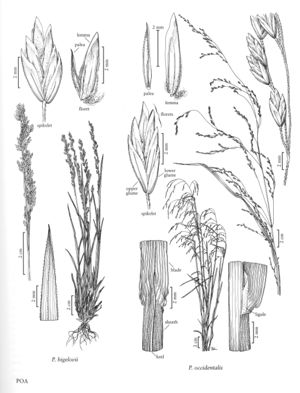Difference between revisions of "Poa occidentalis"
imported>Volume Importer |
imported>Volume Importer |
||
| Line 43: | Line 43: | ||
|publication year= | |publication year= | ||
|special status=Endemic | |special status=Endemic | ||
| − | |source xml=https://bitbucket.org/aafc-mbb/fna-data-curation/src/ | + | |source xml=https://bitbucket.org/aafc-mbb/fna-data-curation/src/200273ad09963decb8fc72550212de541d86569d/coarse_grained_fna_xml/V24/V24_753.xml |
|subfamily=Poaceae subfam. Pooideae | |subfamily=Poaceae subfam. Pooideae | ||
|tribe=Poaceae tribe Poeae | |tribe=Poaceae tribe Poeae | ||
Latest revision as of 16:25, 11 May 2021
Plants perennial, short-lived; densely tufted, tuft bases narrow or not, not rhizomatous, not stoloniferous. Basal branching mixed intra- and extra-vaginal. Culms 20-110 cm. Sheaths closed for (1/5)1/4 – 1/2(3/5) their length, distinctly compressed and keeled, usually densely retrorsely scabrous, rarely sparsely scabrous, margins not ciliate; ligules 3-12 mm, densely scabrous, acute to acuminate; blades (1.2)1.5-6(10) mm wide, flat, lax, apices broadly prow-shaped. Panicles (6)12-40 cm, lax, eventually open, spikelets numerous, with 2-7 branches per node; branches (3)5-18(23) cm, eventually spreading or drooping, angled, angles densely scabrous, with (5)8-40(120) spikelets. Spikelets (3)4-7(8) mm, laterally compressed, with 3-7 florets; rachilla internodes shorter than 1 mm, smooth. Glumes distinctly keeled, keels scabrous; lower glumes 2-3.5 mm, 1-veined; upper glumes 2.5-4.2 mm, shorter than or subequal to the lowest lemmas; calluses webbed; lemmas 2.6-4.2 mm, narrowly lanceolate, distinctly keeled, scabrous distally, keels and marginal veins short- to long-villous, keel hairs extending to midlength, marginal vein hairs to 1/3 the lemma length, lateral veins and intercostal regions usually sparsely softly puberulent, lateral veins prominent, apices narrowly acute; palea keels scabrous, glabrous; anthers 0.3-1 mm. 2n = 14, 28.
Distribution
Ariz., Colo., N.Mex., Tex.
Discussion
Poa occidentalis grows in natural openings and disturbed sites in mixed coniferous forests of the southwestern United States. It is one of the three diploid species of Poa known to be native to North America. The tetraploid count was obtained from a single giant individual. Poa occidentalis has been confused with P. tracyi (p. 543), but P. occidentalis consistently has shorter, well-developed anthers and lacks rhizomes. It also usually has longer ligules relative to the blade width, and is shorter-lived. A few plants are intermediate in some characteristics. Small plants of P. occidentalis sometimes resemble P. reflexa (see next).
Selected References
None.
